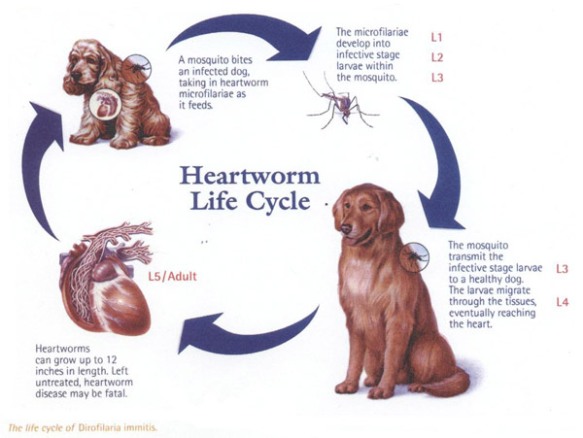What are heartworms?
Heartworms (Dirofilaria immitis) are parasitic worms that can live in the heart, lungs and associated blood vessels of your dog. Male heartworms are four to six inches in length with females being larger at about 10-12 inches when fully grown after one year after infection. These nasty parasites are long-lived and are good at avoiding your dog’s immune system, and on average live inside your dog for about five to seven years.
How does my dog get heartworms?
When heartworms mature at about a year old, the adult worms mate and the females release their offspring  called microfilariae, into the blood stream where they are sucked up in the blood when the dog in bitten by mosquitoes The mosquitoes then go off to drink from another dog and in the process they release the young heartworms into the bloodstream of the dog they have just bitten and thereby infecting the new dog with heart worms to repeat the cycle. While dogs are the definitive host for heartworms they may infect more than 30 species of animals such as other members of the canine (dog) family (coyotes, foxes, wolves) and even domestic cats and ferrets.
Can people get heartworms from dogs?
In extremely rare cases, heartworms have infected people, but it cannot complete its life cycle in a human being. The juvenile heartworm migrates to the lung and cause a spherical lesion that resembles a tumour. But again these are very, very rare cases.
What are the signs or symptoms of heartworm in dogs?
The heart and lungs are the major organs affected by heartworms and will be affected to varying degrees depending on a number of factors such as the level of infection, age of the dog and also the dog’s activity level. Older and active dogs will usually show a greater level of symptoms as they will already have strain placed on their cardiovascular system that is under attack from the heartworms also. A younger dog that is a couch potato is less likely to feel the strain on their cardiovascular resources from a heartworm infection. General symptoms of heartworm infection are a cough that worsens over time and scale of the infection, exercise intolerance, difficulty breathing and abnormal lung sounds, enlargement of the liver, poor blood flow to the brain resulting in temporary loss of consciousness, abnormal heart activity to eventually death.
How to detect heartworm in dogs
Usually a blood test is required to give a definite answer to whether your dog has heartworm or not as usually this is an antigen based test looking for chemical markers that are specific to female heartworms. This is necessary before a dog can begin treatment for heartworm disease.
Preventing and treating heartworm infection in dogs
The best course of action is to prevent heartworm infection in the first place using a product specifically designed for heartworm such as ‘Proheart’ injection that is given once a year when your dog has their vaccination, but other products that are used once a month are also effective. It is just easier for most people to remember the injection once per year than a tablet or spot-on once per month.
Treating heartworm is a much more lengthy and dangerous process as well as being more expensive also. Sometimes prevention may not be an option if you are adopting an older dog or a dog from a shelter or rescue that may already have a heartworm infestation. Your vet will advise you on the appropriate course of action depending on the maturity of the heartworms in your dog but in all cases a dog that is undergoing treatment for heartworm should avoid even moderate exercise.


没有评论:
发表评论